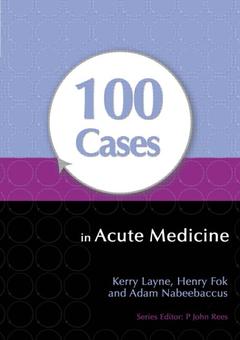Description
100 Cases in Acute Medicine
100 Cases Series
Authors: Layne Kerry, Fok Henry, Nabeebaccus Adam
Language: English
Subjects for 100 Cases in Acute Medicine:
Keywords
White Cells; Shortness of breath and a cough; Young Man; Swollen glands and hearing impairment; Non-invasive Ventilation; The ill returning traveller; Spinal Cord; Sharp central chest pain; CT Head Scan; Back pain and weight loss; Surviving Sepsis Guidelines; Clinical Examination; Liver Functions; Renal Replacement Therapy; Pulmonary Renal Syndromes; Glandular Fever; Acute Pulmonary Oedema; GCS Score; Acute Respiratory Distress Syndrome; Head Injury; Urgent Mri; Serum Complement C3; Transcatheter Aortic Valve Implant
Approximative price 38.06 €
In Print (Delivery period: 14 days).
Add to cartSupport: Print on demand
Description
/li>Contents
/li>Readership
/li>Biography
/li>
A 32-year-old Caucasian lady was admitted to hospital following a collapse at the gym. Her friends described the patient falling to the floor while exercising on the rowing machine, followed by twitching of her arms and legs and a period of being unrousable. You are the medic on duty...
100 Cases in Acute Medicine presents 100 acute conditions commonly seen by medical students and junior doctors in the emergency department, or on the ward, or in the community setting. A succinct summary of the patient's history, examination, and initial investigations, including photographs where relevant, is followed by questions on the diagnosis and management of each case. The answer includes a detailed discussion of each topic, with further illustration where appropriate, providing an essential revision aid as well as a practical guide for students and junior doctors.
Making clinical decisions and choosing the best course of action is one of the most challenging and difficult parts of training to become a doctor. These cases will teach students and junior doctors to recognize important clinical symptoms and signs, and to develop their diagnostic and management skills.
Shortness of breath and a cough. Collapse and confusion in a young woman. Diarrhea with pneumonia. Swollen glands and hearing impairment. Nose bleed (epistaxis) following an operation. Worsening delirium. Deliberate self-harm with painkillers. Lymphadenopathy and malaise. The ill returning traveller. Delirium and urinary symptoms. Headache in pregnancy. Epigastric pain and vomiting. Severe pain in the legs. Chest pain radiating to the back. Shortness of breath (orthopnoea) with a cough. Recurrent abdominal pain. Haemoptysis in a returning traveller. Bloody diarrhoea. Drowsiness and headaches. Progressive lower limb weakness. Seizure and agitation. Substance misuse. Unilateral leg swelling. Vomiting caused by norovirus. Fever and sore throat. Blurred vision. Recurring dizziness with exercise. Palpitations and collapse. Ecchymosis. Petechiae and limb weakness. Generalized weakness and dysarthria. Dysphagia and shallow breathing. Blisters and itchy skin. Shortness of breath following a fall. Swelling of lower limbs. Haemoptysis and shortness of breath. Knee swelling and pain. Bleeding per rectum. Shortness of breath and pedal oedema. Sharp central chest pain. Fever in a returned traveller. Red eyes and sight impairment. Rash and flu-like symptoms. Substance abuse and agitation. Generalized rash and malaise. Pruritic rash and alopecia. Defective vision and eye pain. Abdominal pain with malaise and fever. Painful shoulder and malaise. Facial rash in a patient with SLE. A woman 'off her legs'. Acute confusion. Memory loss and unsteadiness. Postoperative hypotension. Drowsiness bordering on coma. Anxiety with Graves' disease. Episodic anxiety and headache. Shortness of breath in a returning traveller. A fatigued college girl. Haematuria and flank pain. Bradycardia and malaise. Bleeding gums and nose. Palpitations and shortness of breath. Petechial rash and loss of consciousness. Wheeze and productive cough. Wheeze and shortness of breath. Coffee-ground vomiting. Progressive dysphagia and muscle stiffness. Respiratory distress and oedema. Loss of pain sensation. Shortness of breath and in a returning traveller. Confusion following a fall. Apparent adverse drug reaction. Constipation with confusion. Chest pain after exertion. Fevers, weight loss and night sweats. Right-sided chest pain. Shortness of breath in a young non-smoker. Loss of consciousness in diabetes. 'Indigestion' with radiating pain. Suspected opiate overdose. Steady 'deterioration' in functioning. Exacerbation of COPD. Epistaxis and haemoptysis. Collapse associated with a headache. Jaundice and pruritis. Abdominal pain, bruising and confusion. Chest pain with fever, malaise and myalgia. Deteriorating renal function. Flu-like symptoms and generalized weakness. Blurred vision with headache. Severe abdominal pain and feverishness. Self-limiting generalized seizures. Abdominal pain, diarhoea and fever. Target-like rash and fever. Fever, photophobia and neck stiffness. Seizure in heart disease. Back pain and weight loss. Abdominal pain following alcohol excess. Night sweats, polyuria and polydipsia.
Kerry Layne, Core Medical Trainee, Guy's & St Thomas' NHS Foundation Trust, London, UK
Henry Fok
Academic Clinical Fellow, Guy's and St Thomas' NHS Foundation Trust
MB BS, BSc (Hons)
Adam Nabeebaccus
Specialist Registrar, Cardiology, King's College, London, UK
These books may interest you

100 Cases in Clinical Pathology 45.81 €

100 Cases in Clinical Medicine 39.35 €


